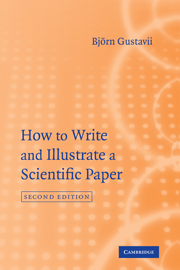Book contents
- Frontmatter
- Contents
- Preface
- Acknowledgments
- 1 Basic rules of writing
- 2 Comments on scientific language
- 3 Drafting the manuscript
- 4 Choosing a journal
- 5 Preparing a graph
- 6 Drawings
- 7 Figure legends
- 8 How to design tables
- 9 Title
- 10 Authors
- 11 Abstract
- 12 Introduction
- 13 Methods
- 14 Results
- 15 Discussion
- 16 Acknowledgments
- 17 References
- 18 Ph.D. and other doctoral theses
- 19 Letters and case reports
- 20 Numbers
- 21 Abbreviations
- 22 How to present statistical results
- 23 Typing
- 24 Dealing with editors and referees
- 25 Correcting proofs
- 26 Authors‘ responsibilities
- Literature needed on your desk
- Further reading
- Literature cited
- Index
9 - Title
Published online by Cambridge University Press: 05 June 2012
- Frontmatter
- Contents
- Preface
- Acknowledgments
- 1 Basic rules of writing
- 2 Comments on scientific language
- 3 Drafting the manuscript
- 4 Choosing a journal
- 5 Preparing a graph
- 6 Drawings
- 7 Figure legends
- 8 How to design tables
- 9 Title
- 10 Authors
- 11 Abstract
- 12 Introduction
- 13 Methods
- 14 Results
- 15 Discussion
- 16 Acknowledgments
- 17 References
- 18 Ph.D. and other doctoral theses
- 19 Letters and case reports
- 20 Numbers
- 21 Abbreviations
- 22 How to present statistical results
- 23 Typing
- 24 Dealing with editors and referees
- 25 Correcting proofs
- 26 Authors‘ responsibilities
- Literature needed on your desk
- Further reading
- Literature cited
- Index
Summary
For every person who reads the whole of a scientific paper, about 500 read only the title (Kerkut 1983). One way to improve this statistic could be to make the title declarative by including what the paper says, not just what it covers.
Whenever possible, use a declarative rather than a neutral title
This title is neutral:
Influence of aspirin on human megakaryocyte prostaglandin synthesis
John Vane, in his classic paper published in Nature in 1971, put it more expressively:
Inhibition of prostaglandin synthesis as a mechanism of action of aspirin-like drugs
(In 1988, Vane was awarded a Nobel Prize in acknowledgment of his discovery. Vane told us how aspirin relieves pain.)
The following declarative title is taken from the biological sciences (Marvin 1964):
Birds on the rise
Goodman et al. (2001) recommended that the study design also be included in the title, as follows (Lee et al 1995):
Improved survival in homozygous sickle cell disease: Lessons from a cohort study
However, the following formulation is notrecommended (Quesada et al 1995):
Leaf damage decreases pollen production and hinders pollen performance in Cucurbita texana
Do the authors really mean to imply that the issue is settled once and for all? Your own present work should be referred to in the past tense:
Leaf damage decreased … and hindered …
This way of using a verb in a title makes it into a sentence. It is stronger than using a phrase, some say too strong.
- Type
- Chapter
- Information
- How to Write and Illustrate a Scientific Paper , pp. 48 - 53Publisher: Cambridge University PressPrint publication year: 2008
- 1
- Cited by



